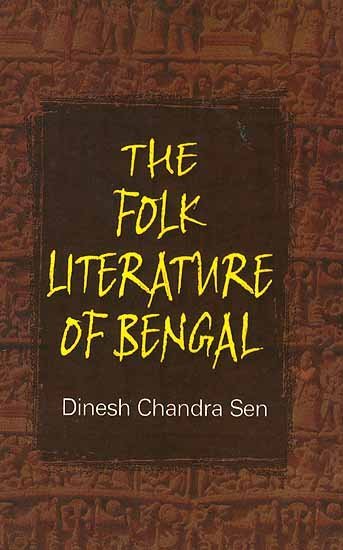Folk Tradition of Bengal (and Rabindranath Tagore)
by Joydeep Mukherjee | 2018 | 49,317 words | ISBN-10: 8186036989 | ISBN-13: 9788186036983
An English study regarding the Folk Tradition of Bengal and its influence on Rabindranath Tagore—an important Bengali polymath from the 19th century who excelled in philosophy, arts (painting), literature and music. This research tries to initiate the semantic aspect of “folk” through the help of various dictionaries....
Chapter 5.4 - Tagore’s interest in Lalon Fakir’s Manuscript
At last his condition was such that only listening could not satisfy him. He was overcharged by a sense of possession. He confessed that he had gone through an old copy consisting of some songs. However, further research enlights that he jotted down almost songs from a copy bought by Bamacharan Bhattacharya. Some critics are of the opinion that Bamacharan himself copied some of the songs. To the contrary the research dissipates that Lalon’s disciples catered a vital information that Tagore frequented them and used to collect their manuscripts from them. Nonetheless, they even launched an obligation against him that he did not return those manuscripts. To some extent, it may be true yet it is hard to believe that he did not respond after several intimations.
Another reference is very supportive here. Dr. Pashupati Sasmal, director of Rabindra Bhaban, Viswa Bharati sent a manuscript of Lalon Fakir to Abul Ansan Chaudhury for the publication of a Lolon centric book. It is mentioned:
Rabindranath Thakur er nikat theke prapta Rabindrabhabanastha pandulipir modhye Lalon Fakir er ganer khata duti ullekhjogya|… Khatar pichon dike lekha shuru hoyeche, orthat procholito orthe sesh prishtha (ba diker) pristha akhyapatra kora hoyeche| Sada kagoje pencil diye line tene besh sposhto hastakshar kalite ganguli lekha| Lal pencil e prishthanko deya ache| Likhito prishithar sankha sarbamot 163 (prothom khata- 68; diwitiyo khata- 95)| Mot ganer sonkha 298| Duti khatar ayoton 17 cm X 21 cm| Prothomkhatai 126 ebong ditito khatai 172 ti gan ache| Er modhye 8 ti gan du bar kore lekha, sei hisabe mot ganer sankha 290| Prothom kono gan tini sangsodhon na korleo, dwitiyo khatai 104, 106 o 121 gan tintite koyekti shobdo nijer hate kete tar thik upore shobdo gulir shuddho path likhe rekhechen|
Translation:
“What is noteworthy is the collected two copies basically manuscripts by Tagore himself. Ideally write up starts from the back of the manuscript along with a preface. With the help of pencil, the lines are drawn in a fair sheet and the songs are written. 163 pages comprising 290 songs, in which the first manuscript consists of 126 songs within 68 pages and the other one 172 songs within 95 pages, are marked by a red pen. Out of 290 songs eight songs are repeated. Though he did not make any correction in the first manuscript, in the second specifically in song no. 104, 106 and 121, he modified some words and wrote the original version just above those scribbles.”
Rabindra Bhavan library contains two such books of Lalon Fakir with some changes done by none other than Tagore himself. Later on Sanat Kumar Mitra published “Lalon-Fakir: Kabi o Kabya” (Lalon Fakir: the Poet and Poetry) incorporating the songs from the manuscript and in 2009 Abul Ansan Chowdhury published–“Rabindranath Songrihito Laloner Ganer Pandulipi” (The Manuscripts of the Songs of Lalon Fakir Collected by Rabindranath Tagore). Shktinath Jha got to know about a book where 375 songs in a book helped Tagore shape his ideas about their language.
The research intends to quote the saying of Kalicharan Ghosh:
Shilaidahe kobi tokon obosthan korchilen Padmar upor| Akdin kusthiyar likat Lalon Shah Fakir er akhrai giya kayekti sangeet songraha koriya anite bolilen| … Tini sei somoy Lalon er besh kichu sishyo der sathe porichoy koriyachilen| … Tara chole jabar por amak bololen ihara lekha pora janena| Kintu eta sokolei gyani, baro baro kotha eto sohoj bhabe bujhaite pare j eder sathe alochana kore j anondo paiyachi, biswaobidyalayer upadhidharider songe alochana koreo ta pawa jai na|
Translation:
“Tagore was in Silaidaha on the bank of river Padma. One day he instructed me to bring a collection of Lalon Shah Fakir’s songs. During that point of time he met some of his disciples for his own importance. After that he informed me that they are not educated but so spontaneous to share the knot of the theories of life. A minute’s conversation with them can fill your heart with pleasure which is rare and rarest even not available among those awarded university professor.”
At last ‘Prabasi Patrika’ which was published in 1322 and published 20 songs of Lalon Fakir attests his craze for his manuscripts.
